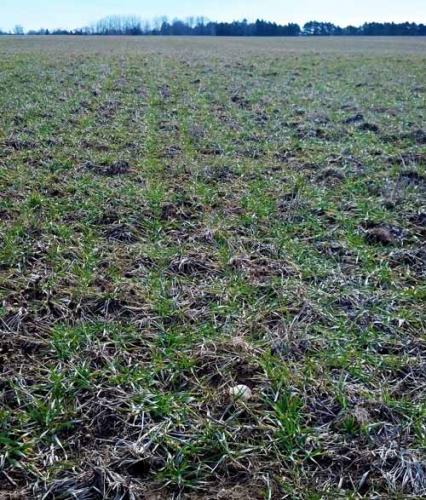Northeast Michigan field crop regional report – April 25, 2013
Cool, wet weather is delaying spring field work and slowing development of the wheat crop across northeast Michigan.
Weather
The first month of spring has felt more like late winter in northeast Michigan with cool and wet conditions persisting across the region. Fields have been quiet as a result and growers are spending most of their time in the shop preparing equipment. No spring tillage or planting has occurred, though some nitrogen applications have been made to wheat and a little manure has been spread on higher, sandier ground. While farmers in the region are not yet officially behind schedule, the long-term forecast is not predicting many opportunities for field operations in the near future.
Rainfall
Eight of the last 13 days have included either rain or snow, with 1.93 inches of total precipitation since April 11. This total is approximately 1 inch above the five-year regional average for the second half of April. The 6-10 and 8-14 day outlooks from NOAA indicate northeast Michigan will likely see above normal precipitation in the next couple of weeks. This means that many fields will remain wet well into May. Yet, it will be good to start the season with a replenished pool of subsoil moisture, and we can be thankful that our area has not seen the 7 or 8 inches that the central Lower Peninsula received this month.
Growing degree days (GDD)
High air temperatures over the last two weeks have ranged from 32 to 61 degrees Fahrenheit with nighttime lows between 16 and 36. Growing degree day (GDD) accumulations since March 1 total 185.2 base 32 F, 39.6 base 42 and 8.1 base 50. This puts us well behind the 66 base 50 GDD average for this point in the season.
This spring has been nearly as unseasonably cold as last year was warm, an interesting contrast with the early accumulation of 140 GDDs by this date in 2012. The medium range outlooks from NOAA suggest temperatures will increase to be closer to normal over the next two weeks.
Commodity reports
Winter wheat growth is a calendar week or two behind in northeast Michigan. Most stands are just beginning to think about greening-up and range in development from Feeke’s stage 2 to stage 3. Planting was timely last fall, but development is limited to two tillers in many fields. Average soil temperatures of 40 F have limited new root growth. Some nitrogen has been applied, but 5 to 25 percent, depending on the form used, was likely lost to leaching.

A no-till wheat field in Presque Isle County showing little new growth.
Photo credit: James DeDecker, MSU Extension
Deer, hungry after a cold and snowy winter, have significantly damaged some wheat in the region. Now that the snow is melted, winter annual and biennial weeds are beginning to grow. This will be a critical year for weed control in wheat due to slow crop development. Michigan State University Extension advises growers assess the weed pressure in their fields and weigh the control options soon.
Alfalfa has yet to break dormancy in the northeast, but a series of highs above 50 F forecast for early next week might do the trick.
No oats, corn, potatoes or soybeans have been planted in northeast Michigan. Statewide, less than 1 percent of the anticipated corn crop is in the ground.
Other field crop regional reports from this week



 Print
Print Email
Email

